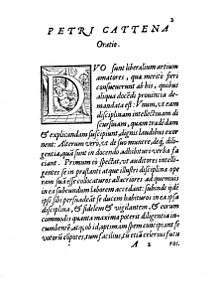Pietro Catena
Pietro Catena (1501–1577) was an Italian astronomer,[1] philosopher, mathematician, theologian and catholic priest, citizen of the Republic of Venice. He was a precursor of the Renaissance scientific revolution and investigated on the relationships between mathematics, logic and philosophy.[2] As a professor in Padua, Catena occupied the same mathematical chair later assigned to Galileo Galilei.[3]

Life

A catholic priest born in Venice in 1501, Pietro Catena was well known as a philosopher and mathematician, and also considered excellent in Greek and Latin.[4][5] He was a public lecturer[6] of Metaphysics[4] and professor of mathematics at the University of Padua from 1548 to 1576,[3] where Giuseppe Moleti and later Galileo Galilei succeeded him.[3]
Catena published in 1556 in Venice Universa loca in logica Aristotelis in mathematicas disciplinas, the collection of pieces from the Aristotelian works that recognized the prevailing speculative character of mathematical knowledge,[7] a theme to which he also devoted another work.[3]
Works
- Catena, Pietro (1549). Astrolabii quo primi mobilis motus deprehenduntur canones. Impressi Paduae: Giacomo Fabriano.
- Catena, Pietro (1563). Oratio pro idea methodi. Patauij: Grazioso Percacino.
References
- "Catena, Petrus". thesaurus.cerl.org. Retrieved 2017-07-06.
- Giulio Cesare Giacobbe (1981). Alle radici della rivoluzione scientifica rinascimentale: le opere di Pietro Catena, sui rapporti tra matematica e logica. Con riproduzione dei testi originali. Domus Galilæana. ISBN 978-88-8381-406-8.
- Stillman Drake (1999). Essays on Galileo and the History and Philosophy of Science. University of Toronto Press. p. 152. ISBN 978-0-8020-8165-0.
- Agostino Superbi (1629). Trionfo glorioso d'heroi illustri, et eminenti dell'inclita, & marauigliosa città di Venetia (in Italian). per Euangelista Deuchino. p. 31.
- Biografia universale antica e moderna ossia Storia per alfabeto della vita pubblica e privata di tutte le persone che si distinsero per opere, azioni, talenti, virtù e delitti (in Italian). 1. 1823. p. 311.
- Giacomo Alberici (1605). Catalogo breue de gl'illustri et famosi scrittori venetiani (in Italian). presso gli heredi di Giouanni Rossi. p. 12.
- Cesare Vasoli (2002). Le filosofie del Rinascimento (in Italian). B. Mondadori. pp. 414–. ISBN 978-88-424-9354-9.